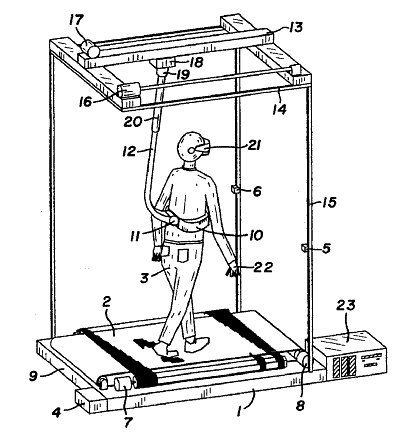 An omni-directional treadmill is just like your traditional gym treadmill, except instead of only being able to go forward, you can move in any direction. There are a number of ways to achieve such omni-directional locomotion, but the resulting machine would be excellent to let virtual reality users to literally stroll around in a virtual environment.
An omni-directional treadmill is just like your traditional gym treadmill, except instead of only being able to go forward, you can move in any direction. There are a number of ways to achieve such omni-directional locomotion, but the resulting machine would be excellent to let virtual reality users to literally stroll around in a virtual environment.
Allowing players to move and interact with a virtual environment in a natural way is one of the key components to creating an immersive virtual world. To date, all input for mainstream gaming has been done with some sort of controller. To walk forward in an FPS, you’re probably pressing forward on a control stick. Even motion controlled games have little or no support for moving your player by actually walking. In the case of the Wii and Kinect, this issue arises because of the small area in which the player is tracked. Even if the tracking area were larger, you’d inevitably run into walks or other objects.
An omni-directional treadmill would let you walk, or even run through massive virtual spaces. Oh and did I mention that omni-directional treadmills already exist? Yeah, actually the first patent for the omni-directional treadmill was awarded all the way back in 1996! See an omni-directional treadmill in action:
[youtube=http://www.youtube.com/watch?v=BQw1tsgrJOs]
The video above is a good demonstration of how a person can move around on an omni-directional treadmill, while the following video gives a better idea of the mechanism at work (because the sides are exposed):
[youtube=http://www.youtube.com/watch?v=3rtX2pWRh6w]
US patent number 5,562,572, awarded to David E. has designs for a number of different omni-directional systems.
Obviously such treadmills would need a lot of space to function. The surface which the user stands on has to be large to allow for some leeway before the direction of the treadmill and catch up to the direction that they’re moving. This means that if you were walking forward, then started to walk backwards suddenly, it would feel normal to you, but your position on the treadmill would actually deviate from the center point. Normally the treadmill counteracts your speed to make your net speed 0; it would compensate when you deviated from the center by giving you a positive net speed toward the center of the treadmill, then go back to a net speed of 0 once you reached the middle. With a head mounted display, you’d be none the wiser.
Because of the expense and size of these treadmills, they wouldn’t be ideal for home VR use. Arcades, however, could make use of such setups. In the same way that you don’t go out to buy a big arcade cabinet (most of us don’t, anway), because they are big and expensive, you likely wouldn’t buy your own omni-directional treadmill setup.







Pingback: Battlefield 3 Played in a Virtual Reality Simulator [video] « Road to Virtual Reality()
Pingback: Carl Zeiss Cinemizer HMD Hands-on Video — Pre-ordering Now « Road to Virtual Reality()
Pingback: Omni Ar 15 Pistol Review()
Pingback: Omni Ar 15 Pistol Review – Fortworth Gun Supplies()